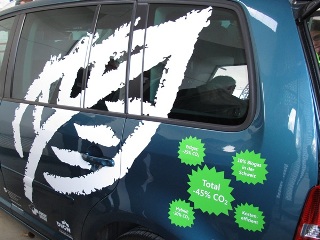Mar 3 2015
Last Wednesday the lecture theatre at the Empa Academy was filled to the very last seat as speakers from the automobile, energy and finance sectors as well as researchers and those involved in the politics of energy presented their views on the potentials and challenges of “synthetic” fuels.
 Our energy supplies are in a state of fundamental flux, the primary challenges being to reduce our CO2 emissions and to move from fossil and nuclear energy sources to renewables. The automobile industry is, of course, also involved in this metamorphosis – in addition to the introduction of vehicles with new power trains, the supply of the appropriate fuels for them is of vital importance. Source: Empa
Our energy supplies are in a state of fundamental flux, the primary challenges being to reduce our CO2 emissions and to move from fossil and nuclear energy sources to renewables. The automobile industry is, of course, also involved in this metamorphosis – in addition to the introduction of vehicles with new power trains, the supply of the appropriate fuels for them is of vital importance. Source: Empa
The latter include such substances as hydrogen or methane, which can be produced using short-term superfluous electric power (for example in the summer months or during periods when hydroelectric power becomes temporarily uncompetitive on the energy market). The Power-to-Gas concept foresees this excess electrical energy initially being used to create hydrogen (H2) from water by electrolysis. This can either be used directly as a fuel or, in a subsequent step, catalytically reacted with carbon dioxide (CO2) to generate methane (CH4). The advantage of methane as a fuel is that it provides a means of storing the superfluous electric power available during the summer period in the existing gas network for several months, so that even in winter gas vehicles can be operated with CO2-neutral fuel.
Reduce CO2 emissions – or face sanctions
One great challenge in the renewable energy sector in this context is cost effectiveness. Energy from renewables is per se more expensive than that from fossil fuels, and when in addition the former is to be stored then the costs increase further, particularly when long-term (e.g. seasonal) storage periods are required. Well-considered strategies are therefore essential if the Power-to-Gas concept is to be made cost-effective – or putting it in the words of Empa researcher Andreas Borgschulte: “The conversion into synthetic power sources is not just an energy problem, it is above all a financial problem.” Swiss legislation covering CO2 emissions offers the basis for such a business case in that it forces the automobile industry to implement wide-ranging CO2 reduction measures. Christian Bach of Empa’s Automotive Powertrain Vehicles provides the appropriate figures: “Exceeding the legal threshold emission values leads to harsh sanctions for car manufacturers. These are estimated to be in the range of CHF50 to 80 million for the current year alone.” And the tendency is upwards. The automobile concerns therefore have to make a decision – should they pay heavy, annually increasing fines or should they invest in renewable energy? Which of these options is ultimately better for the environment is immediately clear. But what is also clear is that investment in renewable energy will only then take place when the automobile manufacturers are allowed to take into account the proven CO2 reductions which occur within the framework of the Fleet Emission Regulations. This is an area in which the administrative and political bodies are currently working.
“If reducing CO2 emissions really is important to us, then we need to look beyond the ends of our noses,” maintains Reiner Mangold of AUDI. As a pioneer in the field of synthetic fuels, AUDI has developed an overall concept for CO2-free mobility, and included in the concept are various drive systems and fuels. The firm has opted for gas power as the primary drive type for the concept, and in collaboration with Etogas, has established a large Power–to–Gas pilot plant in northern Germany. Life cycle analyses show that gas vehicles powered by methane derived from wind energy achieve comparable CO2 emission levels as electrical vehicles whose batteries are charged from wind energy sources. A further part of AUDI’s strategy includes pilot plants which generate diesel or petrol-like liquid fuels from electrical power derived from renewable sources.
Great potential, not yet exhausted
All current technologies used to generate synthetic fuels are initially based on hydrogen, for which reason hydrogen powered vehicles are the subject of growing interest. Powering buses, municipal utility vehicles, commercial vehicles distributing goods at the local level and larger automobiles with hydrogen fuel could be an interesting proposition. The potential for reducing costs by increasing the efficiency of the electrolysis and methanization processes, and optimizing subsequent fuel-cell operation, is a long way from being exhausted. The Paul Scherrer Institute (PSI) is conducting research in this field, and in jointly-developed pilot plants Empa and PSI researchers have been developing and analysing technologies for the future. An assessment made by Empa shows that if only half of the predicted superfluous electric current were to be converted into fuel this would allow several hundred thousand vehicles to be operated in a CO2 neutral manner. Furthermore if this CO2 reduction was allowed to be taken into account in terms of the Fleet Emission Regulations, this step forward would be possible without any subsidies or other financial encouragement measures whatsoever.